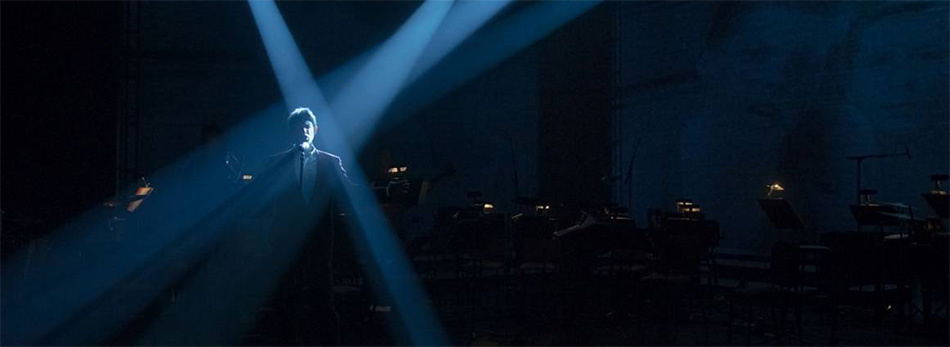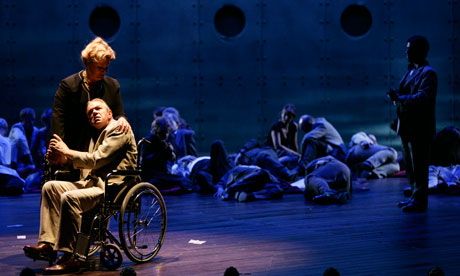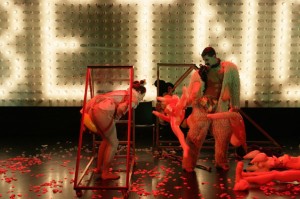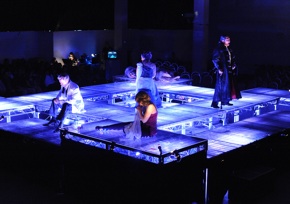Your cart is currently empty!
Tag: John Adams
-

A Little Night Music: 21c Liederabend, Op. L.A.
So much of contemporary art and music is preoccupied with a space, both physical and cerebral, between layers, liminal boundaries – the space between potential and actuality; the ‘what-if’ imponderables of what-was, what-might-have-been, and what-might-be. It’s both archaeological and futuristic. We’re peeling away layers of (terrestrial) crust, even as we’re reaching for a future (and stars) that might not be there.
I came away with something like this threshold sense from Disney Hall’s 21c Liederabend, Op. L.A., a co-production of Beth Morrison Projects and Paola Prestini’s VisionIntoArt, presented under the auspices of the Los Angeles Philharmonic’s Green Umbrella series – with John Adams both conducting the Philharmonic’s New Music ensemble and contributing excerpts from his own I Was Looking at the Ceiling and then I Saw the Sky. Like the John Adams songs, much of the programming was excerpted from more extensive song-cycles or quasi-operatic or theatrical works in progress, with visual (mostly video) elements that, with only one or two exceptions also appeared to be works in progress – some of them rough approximations of what they might evolve into. Others just plain rough. The video was projected onto a four-screen array – one large square screen above three smaller rectangles – which in at least one instance (the Hubble Cantata) spilled over beautifully into the Gehry ‘french-fries’ organ installation and surrounding space. There was a certain amount of frictive buzz about the video at intermission with a number of vocal complaints about the quality, or even the need for it – especially when the music itself was so new and the focus was clearly on the musicians and vocalists. It was hard to argue the point when – with musicians like Vicki Ray, the brilliant L.A. Phil woodwind crew, vocalists like Peabody Southwell, Nathan Gunn and Cedric Barry, the incomparable Timur and his genius Dime Museum, Jessica Rivera (and I won’t go on) – music and lyrics were in fact more than enough. For the moment….
There were no supertitles because of the video installation, so I (and most of the audience I have to guess) really were focused on the songs by themselves. But I could understand the impulse to give a kind of storyboard glimpse into the stories and production ideas that fed into them as parts of longer song cycles or full-blown opera or theatrical productions. Even if it only worked as an adjunct to the (at moments) brilliant live performances, it never seriously intruded, while giving a hint (or more) of where such performances might ultimately be taken.
The video was also used for introductions to the songs/selections by the composers themselves. This was both slightly offputting and bemusing. Did I really need to hear this? I wondered; yet it was undeniably arresting. Then half the time I found myself still more surprised by the music that had actually been composed. The evening was fully of these little starts and jumps. Straightaway I was surprised (pleasantly) by Adams’ distinctly non-Minimalist I Was Looking…. Complex and multi-layered, heavily jazz-inflected especially in the brass and winds, yet steadily driving through the polyrhythmic textures, the songs evoked different moods to match their episodes: a cop self-righteously arresting an innocent bystander, the carnival of confusion (and still more self-justification) that follows; and an epiphanal moment in the somewhat delayed (non-)resolution.
Without addressing the totality of the Adams songs or their success (I liked what I heard), the moment of ‘non-resolved epiphany’ set the tone for an evening that was continuously taking us by surprise in ways we could scarcely define. Listening to David T. Little’s less-than-promising description of his project for Timur and the Dime Museum, I steeled myself for disappointment – it sounded like such a mashed rehash of ideas overworked to death by everyone from Reich to Ashley to Chris & Cosey of Throbbing Gristle – to, I don’t know, Brion Gysin??? The title alone plunged me into despair (‘Artaud in the Black Lodge??’ – I have my apartment for that….) Well, maybe it was that ‘I don’t know’ factor (then too, the texts by Anne Waldman date back to that period) – but, what poured forth from Timur and his genius mates (including Daniel Corral, genius in his own right), was dark, steely (yes, a little ‘industrial,’ too), also chromatic, slashing, soaring and brilliant. It didn’t hurt that Timur was in especially fine voice – taking the near baritone-lows and soaring mezzo/soprano highs with unsurpassed clarity and brilliance.
The dark cathode-ray industrialism of Little’s Artaud (the video projections were by S. Katy Tucker) were a stunning contrast to the white light/sand/snow imagery of the Jacob Cooper/Greg Alan Brownderville songs that preceded it, from Ripple the Sky (an L.A. Phil commission), in which the video was by Cooper himself. Here, the largely high-register, microtonal music seemed almost overwhelmed by the alternately desert/alpine imagery – blinding white sand/snow/salt – appropriate for an elegy to a desertified planet – fading out into lights and monitors; but leaving the audience without any real ‘shards of song’ to hold onto.
Leaha Maria Villareal’s Never Not – with its Beckett-ian text by Adara Meyers – might have adopted a comparable white-out aesthetic, but worked with a slightly more chromatic palette drawn from nature (or at least viewed through a time-lapse lens); also more musically chromatic and beautifully textured with string quintet, keyboards, woodwinds, chimes, and most importantly Peabody Southwell’s sharp, emphatically phrased vocal. Ted Hearne’s when you hear, taken from his Sound From the Bench, with a text by Jena Osman, made reference to a line sampled from a text on ventriloquism by Charles Henry Olin, “when you hear that distant sounding drone, / you know you have your mouth as it should be,” but its successfully imparted sense of displacement relied heavily – not only on the supple, jazz-inflected musicianship (cf., Miles Davis, Ornette Coleman – with a touch of digital delay) of Taylor Levine and James Moore and their New Music cohorts – but on the robust choral tapestry of the Los Robles Master Chorale (under Lesley Leighton’s. direction). (The video – a grid that morphed from curtain walls to a matrix of spinning ventriloquist dummies was serviceable – but nothing as breathtaking as the music.)
Paola Prestini’s excerpts from The Hubble Cantata – inspired by the work of Mario Livio on the Hubble Space Telescope – could not help being the high point of the evening visually as well as musically – with its spectacular Hubble telescope photography of galaxies, nebulae and supernovae in deep space spilling over the screens and into the vaults of Disney Hall. But notwithstanding the ‘Champagne supernova’ of the L.A. Phil musicians, the sonorous Los Robles Master Chorale, and the visuals, I wondered if it were simply Mario Livio’s own words – spoken by Livio himself – that were its most inspiring aspect. It brought the evening beautifully full circle: the species that rarely seems capable of seeing beyond its own ceilings found a moment of cold comfort staring into the cosmos. We’ll be joining those bright and dark stars soon enough.
-

Pushing Opera to Its Furthest Edge
It’s no secret to readers of this blog that awol’s location coordinates can occasionally be tracked to an opera house, whether in this city (the Dorothy Chandler Pavilion, or more recently, across the street at Disney Hall), Long Beach, or further afield (which usually means the Metropolitan Opera in New York). Opera has gravitated towards the big stage since early in its evolution for reasons cultural and political, as well as musical and theatrical. Opera is always big, even when the production is relatively small, because the themes, ideas, motives, and emotions are amplified and played out with a richness, intensity and scale rarely possible in legitimate theatre (or musical for that matter) or in other media. (There are exceptions — plays or even films which, in their dramatic scope, structure, texture and emotional resonance, are latently operatic. Tennessee Williams’ A Streetcar Named Desire – recently seen in the Los Angeles Opera’s staging of the Previn/Litell opera – is almost a textbook example of this. Conversely, there are operas that have a ‘cinematic’ sweep – e.g., Don Carlo.)
Mark Swed had a number of points to make (or un-make as it seemed) in his screed in last Sunday’s (June 29) Los Angeles Times, though it was difficult to sort them out through the contradictions and distortions (and, it would appear, an anti-union bent). The main point that seemed to come across (if you could get past his preoccupation with Met Director Peter Gelb’s travails) was that opera, in its transposition and distribution across a number of different venues and media platforms, was becoming what we might call a ‘big, hot mess.’
Well yeah – I guess so. Isn’t that why we’re still going? I’ll always be a sucker for the Met’s Zeffirelli production of Puccini’s La Bohème; but I’m not necessarily going out of my way to see the umpteenth production of Bizet’s Carmen or even Mozart’s Don Giovanni (a favorite). The best operas endure, but the conversation changes. We sing the same arias – but with a different vocabulary (key, register, etc.), conditioned by the most elemental social, economic, environmental factors as well as culture and technology. We see and hear with different eyes and ears, and what inspires us theatrically changes constantly. No – opera is very much alive – perhaps more so than it’s been in a couple of decades. And we really don’t need to worry about it getting bigger or smaller, migrating to screens, non-theatrical venues, or even hybridizing amongst other forms or formats and media. (We see evidence of this in recent dance, performance art and alternative musical performance.) This is all part and function of its evolution as an art form; and we need to recognize and embrace it, even as we’re blown away for the zillionth time by a Met Bohème or the gypsy ballet in Carmen or a trio in Così.
Although I have no doubt the Met is seriously gauging the impact of its HD cinema broadcasts in the New York metro area against declining box office receipts in Manhattan (and new productions are always going to need angels to back or simply gift them), neither the Met, nor any other major international opera house is in any danger of disappearing. Which is another thing about the big operatic institutions – whether at the heart of an urban metropolis or on the festival circuit: they’ve been criss-crossing and hybridizing for most of their histories for the simple reason that they’ve always acted globally, crossing international boundaries for talent, inspiration, audiences and creative partners.
Nor is there any danger of the big stage being eclipsed by the big screen, much less the little screen. Among the so-called ‘lively arts,’ opera may or may not be the liveliest, but it’s surely the most intense. What is the notion of ‘great performance’ without the standard of the operatic diva transfigured into that musical demiurge capable of delivering the highest notes and deepest emotions to the ‘angels’ of the topmost balcony? While in theory, the HD broadcast puts you in the theatre’s ‘sweet spot,’ we don’t have quite the same connection – even compared to the back rows or top balconies.
A screen is after all another filter, and a reductive one – with the key distinction that we’re no longer participants. (The theatrical distancing is already there, defined both by the musical form and theatrical conventions.) Nothing matches the live performance for sheer electricity. We’re swept up in the musical moment with a force rarely equalled in other entertainments. The best operas make us both witnesses and participants in the performance. We’re part of the moment, part of the architecture of the performance.
One of the fascinations of The Industry’s and L.A. Dance Project’s joint production of Invisible Cities last year was its exploration of this temporal and spatial architecture alongside an engineered intersection with the virtual/participatory aspects of the operatic experience. The ‘center-stage’ focal points were set in artfully choreographed motion, yet without diluting their transfigurative power. It was a dual micro/macro approach to the medium. It left the proscenium stage for a different kind of ‘big’ or ‘grand,’ sprawling across a swath of Union Station, while performing to an audience scarcely larger than 100 people. (Yet no one in the vicinity would have been unmoved. The ‘balcony angels’ here were the passengers and passers-by at the terminal.)

Jelinek’s “Sleeping Beauty” (2008 Beth Morrison Projects production) As opera (like any other art form) reacts and responds to the most urgent ideas, conditions and questions the culture puts before us, its conventions must inevitably be challenged, flexed and pressed to the furthest edge. The Industry is just one company exploring this terrain. There are others – e.g., Beth Morrison Projects, Opera Cabal, Long Beach Opera itself arguably; and many more. It’s a hot messy business, but they’re all vital to the future of the art form, vital in fact to the big stage, the biggest houses, because that’s usually where the largest, most central, and most far-reaching conversations take place – or in any case, where they should.
Which brings us to Gelb’s poor decision to cancel the HD simulcast of John Adams’ The Death of Klinghoffer. The decision may be something of a wash. The opera remains scheduled for its full run; and the controversy may even fill more seats in the house. But it sends a bad message if Gelb is serious about reaching out to new audiences (including those once expected to access Met performances via the simulcasts). That Klinghoffer should even be considered controversial some 23 years after its premiere is simply ludicrous. ADL-fed claims that it might encourage anti-semitism are absurd. This is really belated censorship, undoubtedly embraced by apologists for the Netanyahu regime. One could only hope it spurs further discussion about Zionism in overdrive. (We don’t hear much protest from the ADL about aggressive Israeli settlement building in the West Bank or squeezing Palestinian residents out of East Jerusalem.) But the larger point is simply that the Met should embrace whatever might remain controversial about this opera; and should be commissioning new operatic works that are even more politically controversial. (It frankly amazes me that we haven’t seen operas yet about the Bush administration wars, about Benazir Bhutto and the ISI, about the planetary environmental crises, the digital/cyber-tech explosion and financial melt-down and so much more.)

Long Beach Opera 2011 production of Cherubini’s “Medea” Yes, it all costs money – all the more reason why the Met and other opera companies (including the Los Angeles Opera) should be forging new creative partnerships, to workshop new operas the same way major Broadway shows are developed. Companies like The Industry, Beth Morrison, et al. are already leading the way. The Industry presented an adventurous “First Take” program of operas-in-progress just last year at the Hammer Museum, including new work by Alexander Vassos, Ellen Reid, the legendary Pauline Oliveiros and Mohammed Fairouz. Swed also failed to note that, despite Gelb’s handwringing over labor negotiations and the cinematic cannibalization of the Met’s ‘metro’ audience, the English companies referenced in the Guardian article – the Royal Opera and English National Opera – are thriving, as are a number of other major European houses. And while Swed is complaining about union labor overhead (does he have any clue how much it costs to live in New York?—or for that matter any other big city?), I’ll just get a bit political here and say that the flattening of philanthropic donations and production underwriting is one more indicator that taxes on the very wealthy should be dramatically increased. It’s what the one-percent would call “incentivizing.”
This is about where the standards and requirements of high culture meet the realities of mass entertainment. Opera (like so many manifestations of ‘high culture’) will never be for everyone – nor is it necessarily an ‘everyday’ thing even for those of us who are passionate about it. But in a 24/7 mass culture/media/entertainment environment, you better give people something to talk about.



